
Concept
Universal Inputs/Outputs
The universal inputs/outputs are ideal for any mix of temperature, pressure, flow, status points, and similar point types in a building control system.
As counter inputs, the universal inputs/outputs are commonly used in energy metering applications. As RTD inputs, they are ideal for temperature points in a building control system. As supervised inputs, they are used for security applications where it is critical to know whether or not a wire has been cut or shorted. These events provide a separate indication of alarms and events in the system.
The universal inputs/outputs are capable of supporting analog outputs of type voltage outputs. Therefore, the universal inputs/outputs support a wide range of devices, such as actuators.
Connect only devices with safe extra low voltage equipment (SELV/PELV) inputs/outputs to the controller universal inputs/outputs. Connecting devices that are not SELV/PELV poses an electrical hazard that will result in death or serious injury. The controller inputs/outputs are not SELV/PELV.
The RP-C controller models have universal inputs/outputs of type Ub.
Inputs
The universal inputs/outputs can be configured to read several different types of inputs:
Digital
Counter
Supervised
Voltage
Current
Temperature
Resistive
2-Wire RTD temperature
The external connection of a digital input is shown in the following figure.
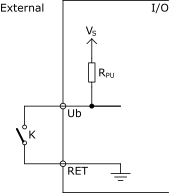
Digital input external connection
K is the monitored external switch.
V S = 24 V
R PU = 10 kohm
A counter input uses the same hardware configuration as the digital input that is shown in the figure above.
Supervised inputs are contact closing inputs supplemented with the supervision of the field wiring integrity. This supervision is a required feature in many security system applications. The supervised inputs provide the ability to detect specific forms of tampering or trouble with the wire connections to the field contacts. The supervision is achieved with a combination of 1 or 2 resistors attached to the contact in the field. The resistor combination creates continuous current flow through the field contact loop and presents a defined set of expected resistance values for each of the defined conditions. If someone is attempting to defeat the monitoring of the field contact by short circuiting the wire with a jumper or cutting the wire, the objective is to detect and indicate such a condition. The resistors need to be located at the end of the cable close to the field contact, so that the point where there is a risk that the circuit is defeated is between the resistors and the I/O.
Three different types of supervised input connections are supported:
Series only
Parallel only
Series and parallel
Each type of supervised input connection provides a different capability in regards to what form of tamper/trouble can be detected regardless of switch contact open or closed condition.
Series only: A single resistor, which is connected in series with the switch, can only detect tamper/trouble in the form of a short circuit across the wire pair. A single series resistor supervision is frequently configured with a normally closed field contact. This provides for the short circuit to be detected and a cut wire will show as an alarm condition. The external connection of a series only supervised input connection is shown in the following figure.
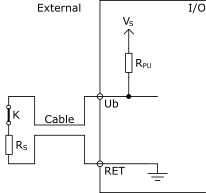
Series only external connection
K is the monitored external switch.
R S = 1 to 10 kohm
V S = 5 V
R PU = 10 kohm
Parallel only: A single resistor, which is connected in parallel with the switch, can only detect tamper/trouble in the form of an open circuit in the field wiring loop. With single parallel resistor supervision and use of a normally open switch in the field, the opened wiring shows as a detected fault and the shorted wiring shows as an alarm condition. The external connection of a parallel only supervised input connection is shown in the following figure.
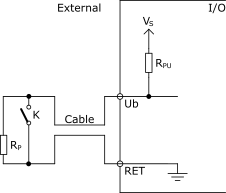
Parallel only external connection
K is the monitored external switch.
R P = 1 to 10 kohm
V S = 5 V
R PU = 10 kohm
Series and parallel: Two resistors, where one is connected in series with the switch and one is connected in parallel with the switch, can detect tamper/trouble conditions in the form of both an open and a shorted circuit. The external connection of a series and parallel supervised input connection is shown in the following figure.
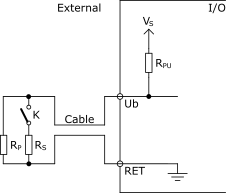
Series and parallel external connection
K is the monitored external switch.
R P = R S ± 5 %, 1 to 10 kohm
V S = 5 V
R PU = 10 kohm
The external connection of a voltage input is shown in the following figure.
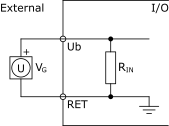
Voltage input external connection
V G is the monitored external voltage (0 to 10 VDC).
R IN = 100 kohm (RP-C-12A-F-24V, RP-C-12B-F-24V, RP-C-12C-F-24V, and RP-C-16A-F-230V)
R IN = 1 Mohm (RP-C-16B-F-24V and RP-C-16B-F-230V)
The external connection of a current input is shown in the following figure.
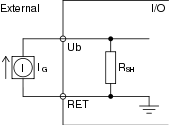
Current input external connection
I G is the monitored external current (0 to 20 mA).
R SH = 47 ohm
In the internal configuration of the current input, there is a current limit circuit in order to help protect the shunt resistor from over load. The input current is limited to 40 mA with a serial connected FET transistor. If this limit is reached for 0.5 seconds, the transistor is turned off. When 5 seconds have elapsed, the transistor is turned on again to make a new start attempt.
The external connection of a temperature input is shown in the following figure.
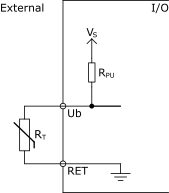
Temperature input external connection
R T is the monitored external thermistor.
When a universal input is used as a temperature input, V S and R PU in the internal configuration of the universal input are used according to the following table.
|
Thermistor type |
V S |
R PU |
|
20 kohm |
5 V |
10 kohm |
|
10 kohm |
5 V |
10 kohm |
|
2.2 kohm |
1 V |
1.5 kohm |
|
1.8 kohm |
1 V |
1.5 kohm |
|
1 kohm |
1 V |
1.5 kohm |
The resulting voltage across the thermistor is measured and a temperature is calculated dependent on the selected thermistor type.
The external connection of a resistive input is shown in the following figure.
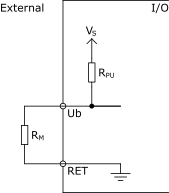
Resistive input external connection
R M is the monitored external resistance.
V S = 5 V
R PU = 10 kohm
The external connection of a 2-wire RTD temperature input is shown in the following figure.
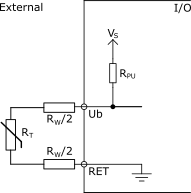
2-wire temperature input external connection
R T is the monitored external RTD.
R W is the wiring resistance.
V S = 1 V
R PU = 1.5 kohm
When an input is used as a 2-wire RTD temperature input, you need to specify the wiring resistance in the software.
The input is measuring the total resulting voltage and the voltage across the RTD is calculated. The voltage across the RTD is then converted to a raw resistance value.
Outputs
The universal inputs/outputs can be configured as voltage outputs.
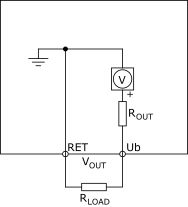
Voltage output internal configuration and connection of external resistive load
R OUT is approximately equal to 10 ohm.
V OUT range is 0 to 10 VDC.
R LOAD minimum is 2.4 kohm.
The voltage output rating differs between different hardware versions of the RP-C controller models RP-C-12A-F-24V, RP-C-12B-F-24V, RP-C-12C-F-24V, and RP-C-16A-F-230V. For more information, see Differences Between RP-C Hardware Versions .
Specifications
Channels, RP-C-12A-F-24V
|
8 Ub, Ub1 to Ub8
|
||||||||||||
Channels, RP-C-12B-F-24V
|
8 Ub, Ub1 to Ub8
|
||||||||||||
Channels, RP-C-12C-F-24V
|
4 Ub, Ub1 to Ub4
|
||||||||||||
Channels, RP-C-16B-F-24V
|
8 Ub, Ub1 to Ub8
|
||||||||||||
Channels, RP-C-16A-F-230V
|
8 Ub, Ub1 to Ub8
|
||||||||||||
Channels, RP-C-16B-F-230V
|
8 Ub, Ub1 to Ub8
|
||||||||||||
Absolute maximum ratings
|
-0.5 to +24 VDC
|
||||||||||||
A/D converter resolution
|
16 bits
|
||||||||||||
Universal input/output protection
|
Transient voltage suppressor on each universal input/output
|
||||||||||||
| Digital inputs | |||||||||||||
Range
|
Dry contact switch closure or open collector/open drain, 24 VDC, typical wetting current 2.4 mA
|
||||||||||||
Minimum pulse width
|
150 ms
|
||||||||||||
| Counter inputs | |||||||||||||
Range
|
Dry contact switch closure or open collector/open drain, 24 VDC, typical wetting current 2.4 mA
|
||||||||||||
Minimum pulse width
|
20 ms
|
||||||||||||
Maximum frequency
|
25 Hz
|
||||||||||||
| Supervised inputs | |||||||||||||
5 V circuit, 1 or 2 resistors
|
|||||||||||||
Monitored switch combinations
|
Series only, parallel only, and series and parallel
|
||||||||||||
Resistor range
|
1 to 10 kohm
|
||||||||||||
| For a 2-resistor configuration, each resistor must have the same value +/- 5 % | |||||||||||||
| Voltage inputs | |||||||||||||
Range
|
0 to 10 VDC
|
||||||||||||
Accuracy
|
+/-(7 mV + 0.2 % of reading)
|
||||||||||||
Resolution
|
1.0 mV
|
||||||||||||
Impedance
|
100 kohm
|
||||||||||||
| RP-C-12A-F-24V, RP-C-12B-F-24V, RP-C-12C-F-24V, and RP-C-16A-F-230V | |||||||||||||
Impedance
|
1 Mohm
|
||||||||||||
| RP-C-16B-F-24V and RP-C-16B-F-230V | |||||||||||||
| Current inputs | |||||||||||||
Range
|
0 to 20 mA
|
||||||||||||
Accuracy
|
+/-(0.01 mA + 0.4 % of reading)
|
||||||||||||
Resolution
|
1 μA
|
||||||||||||
Impedance
|
47 ohm
|
||||||||||||
| Resistive inputs | |||||||||||||
10 ohm to 10 kohm accuracy
|
+/-(7 + 4 x 10
-3
x R) ohm
|
||||||||||||
| R = Resistance in ohm | |||||||||||||
10 kohm to 60 kohm accuracy
|
+/-(4 x 10
-3
x R + 7 x 10
-8
x R
2
) ohm
|
||||||||||||
| R = Resistance in ohm | |||||||||||||
| Temperature inputs (thermistors) | |||||||||||||
Range
|
-50 to +150 °C (-58 to +302 °F)
|
||||||||||||
| Supported thermistors | |||||||||||||
Honeywell
|
20 kohm
|
||||||||||||
Type I (Continuum)
|
10 kohm
|
||||||||||||
Type II (I/NET)
|
10 kohm
|
||||||||||||
Type III (Satchwell)
|
10 kohm
|
||||||||||||
Type IV (FD)
|
10 kohm
|
||||||||||||
Type V (FD w/ 11k shunt)
|
Linearized 10 kohm
|
||||||||||||
Satchwell D?T
|
Linearized 10 kohm
|
||||||||||||
Johnson Controls
|
2.2 kohm
|
||||||||||||
Xenta
|
1.8 kohm
|
||||||||||||
Balco
|
1 kohm
|
||||||||||||
| Measurement accuracy | |||||||||||||
20 kohm
|
-50 to -30 °C: +/-1.5 °C (-58 to -22 °F: +/-2.7 °F)
|
||||||||||||
-30 to 0 °C: +/-0.5 °C (-22 to +32 °F: +/-0.9 °F)
|
|||||||||||||
0 to 100 °C: +/-0.2 °C (32 to 212 °F: +/-0.4 °F)
|
|||||||||||||
100 to 150 °C: +/-0.5 °C (212 to 302 °F: +/-0.9 °F)
|
|||||||||||||
10 kohm, 2.2 kohm, and 1.8 kohm
|
-50 to -30 °C: +/-0.75 °C (-58 to -22 °F: +/-1.35 °F)
|
||||||||||||
-30 to +100 °C: +/-0.2 °C (-22 to +212 °F: +/-0.4 °F)
|
|||||||||||||
100 to 150 °C: +/-0.5 °C (212 to 302 °F: +/-0.9 °F)
|
|||||||||||||
Linearized 10 kohm
|
-50 to -30 °C: +/-2.0 °C (-58 to -22 °F: +/-3.6 °F)
|
||||||||||||
-30 to 0 °C: +/-0.75 °C (-22 to +32 °F: +/-1.35 °F)
|
|||||||||||||
0 to 100 °C: +/-0.2 °C (32 to 212 °F: +/-0.4 °F)
|
|||||||||||||
100 to 150 °C: +/-0.5 °C (212 to 302 °F: +/-0.9 °F)
|
|||||||||||||
1 kohm
|
-50 to +150 °C: +/-1.0 °C (-58 to +302° F: +/-1.8 °F)
|
||||||||||||
| RTD temperature inputs | |||||||||||||
Supported RTDs
|
Pt1000, Ni1000, and LG-Ni1000
|
||||||||||||
| Pt1000 | |||||||||||||
Sensor range
|
-50 to +150 °C (-58 to +302 °F)
|
||||||||||||
|
|||||||||||||
| Ni1000 | |||||||||||||
Sensor range
|
-50 to +150 °C (-58 to +302 °F)
|
||||||||||||
|
|||||||||||||
| LG-Ni1000 | |||||||||||||
Sensor range
|
-50 to +150 °C (-58 to +302 °F)
|
||||||||||||
|
|||||||||||||
| RTD temperature wiring | |||||||||||||
Maximum wire resistance
|
20 ohm/wire (40 ohm total)
|
||||||||||||
Maximum wire capacitance
|
60 nF
|
||||||||||||
| The wire resistance and capacitance typically corresponds to a 200 m wire. | |||||||||||||
| Voltage outputs | |||||||||||||
Range
|
0 to 10 VDC
|
||||||||||||
Accuracy
|
+/-60 mV
|
||||||||||||
Resolution
|
10 mV
|
||||||||||||
Minimum load resistance
|
2.4 kohm
|
||||||||||||
Source current
|
+4.2 mA
|
||||||||||||
Sink current
|
-1 mA (0 to 0.4 VDC)
|
||||||||||||
-4.2 mA (0.4 to 10 VDC)
|
|||||||||||||
 RP-C Controllers
RP-C Controllers
 RP-C Onboard I/O
RP-C Onboard I/O
 Danger
Danger